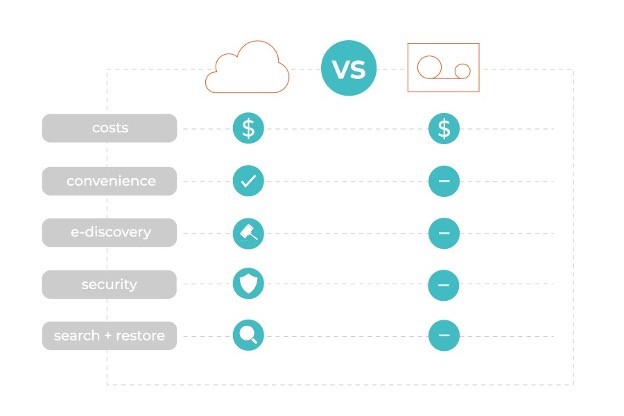Cloud or tape for long-term data retention?

Cloud or tape for long-term data retention? It’s not that simple.
When it comes to long-term data retention, tape and cold cloud storage invariably come up as the best alternatives, though each one has its advantages and disadvantages.
If all you need is to store massive amounts of data cheaply, and rarely require search or restore, then either tape or cold cloud storage will do for long-term data retention. Both are more economical than disk storage. But these days, even old data is subject to user demand, business analysis, investigations, eDiscovery searches, and the European Union’s (EU) General Data Protection Regulation (GDPR) right to be forgotten. That means the “good enough” solution isn’t nearly enough.
The basics of storing aging data in tape and cloud
Tape libraries are expensive to buy and scale. But if IT amortizes storage expenses relative to capacity, within a few years tape becomes less expensive than the same amount of disk-based capacity. IT also saves money and increases library capacity by cycling cartridges off-site.
Remote vaulting costs are low, IT complies with retention requirements, and cyberattacks are non-existent. Portable media has another advantage: it’s perfectly possible to ship massive volumes of data to any place in the world within a day. Try doing this online by uploading 500TB of data in 24 hours. (You can’t.)
The disadvantages of tape for long-term data retention
It may be more economical than cloud storage over the long run, but even starting level tape libraries aren’t cheap to buy or operate. Then there is the major problem of searching backup tape for compliance or eDiscovery. Even archives are an issue if thousands of tapes are stored off-site.
Many companies turn over large-scale search projects to outside services, but it costs them. Large enterprises that receive an eDiscovery demand to search years’ worth of email from multiple custodians can attest to the true costs of tape.
There have been numerous cases in the past decade where organizations have ended up spending more than $1 million to a tape restoration provider to take thousands of backup tapes and restore them into a searchable archive. Keep that in mind the next time someone tells you their tape backups are their approach to archiving.

Cloud storage to the rescue
Basic cold cloud storage also has advantages. Inexpensive cold storage tiers are more economical than buying and scaling sufficient disk-based storage for aging data. And unlike tape library purchases, the cloud can be more cost-effective when starting out with pay-as-you-grow services.
It’s true the cloud means cybersecurity is more of an issue than off-site tape. However, encryption, strong authentication, and creating allow and deny lists of IP addresses in single tenancy architectures guard against most intrusion attempts. It’s also far easier to search and restore from an online data repository than a tape vault.
But like tape, it’s not a perfect picture. With cloud, you need to think about network bandwidth issues and the time and cost of uploads and restores. Although tape costs more at the outset, cost-per-GB drops with tape as it spreads over a bigger volume of data. In the cloud, that inexpensive beginning will grow as businesses move more and more data online.
Adding real value to long-term data
Long-term retention has typically been synonymous with cold/offline storage, making tape the ideal media.
Tape advocates and vendors commonly point out the unmatched storage economics one can achieve with tape. But I think organizations are now hungry for more than just cheap storage. There’s a business need for agile data management tools with fast, hassle-free access.
The long-accepted approach to long-term retention is changing with the cloud.
Cloud-based cold storage with intelligent storage software drives the same base benefits of low-cost and high-security as tape, but it revolutionizes data management because it is an intelligent secondary storage layer.
Organizations are rethinking tape and shifting to cloud data management with tools like Veritas NetBackup SaaS Protection for their long-term retention because they want:
Convenience. Cloud storage uses native disk formats with granular object-level controls, so businesses don’t need to keep copies of old software on hand. The architecture supports data retention schedules and data management while it safely stores files, email, event logs, and machine-generated data.
Security. Cold blob storage offers tamper-proof WORM storage, litigation holds for compliance and eDiscovery, and encryption of data in motion and at rest.
Efficiency. Deep archiving in the cloud lets you easily search and restore archived data on demand – an impossible task with offline tape.
The future is here: Hybrid cloud data management
Organizations are learning that, with the cloud, they can run lean and mean on-premises infrastructures by using cloud data management platforms as an automatic release valve for the aging or inactive data on primary storage. They can offload data without disrupting users or applications to streamline their existing backup processes. Meanwhile, in the cloud, Veritas NetBackup SaaS Protection serves as a forever incremental that converges data protection, active archiving, and long-term retention.
Given these benefits, it makes sense to replace tape libraries with a cloud-based secondary storage layer. The trick, of course, is to find the right cloud storage solution to meet your long-term data retention needs.
